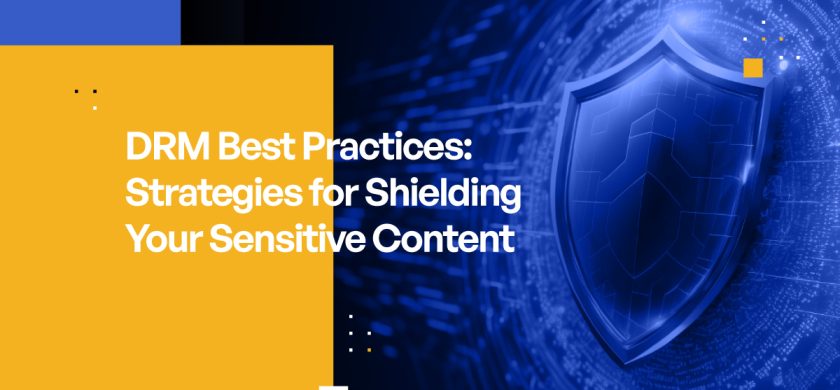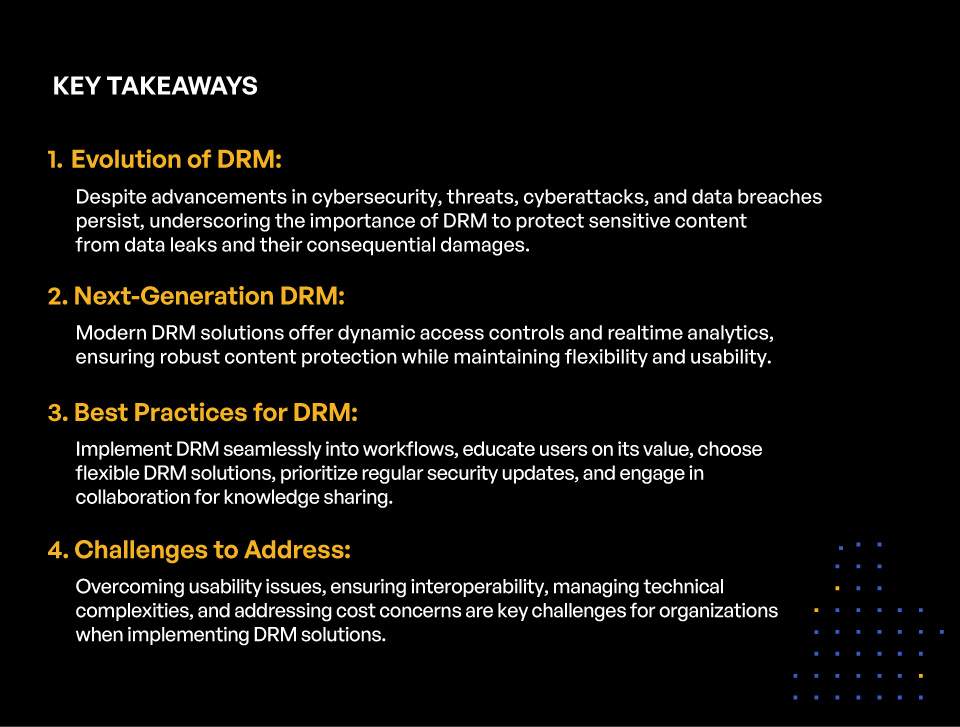
DRM Best Practices: Strategies for Shielding Your Intellectual Property and Other Sensitive Content
As organizations increasingly produce, process, and share sensitive content, the imperative to protect this information increases dramatically. Despite massive improvements in cybersecurity technology, sensitive content like customer, patient, and student records, financial information, product specifications, and contracts continues to leak, whether caused by cyberattacks, human error, or other cyber threat. Data breaches can have calamitous effects including regulatory fines and penalties, litigation, customer and revenue loss, and brand erosion.
Digital rights management (DRM) technology provides organizations the means to protect sensitive information so that only authorized users can access it. This detailed guide explores the advancements in DRM technology and provides best practices for vetting, implementing, and using a next–generation DRM solution.
Wondering if digital rights management can protect your priceless intellectual property? The simple answer is yes but you’ll want to be sure to avoid these four DRM stumbling blocks.
Digital Rights Management: What’s Changed?
Digital rights management technology has long served as a critical tool for protecting intellectual property, essentially controlling access to digital media like software, eBooks, music, and movies. DRM has helped creators and copyright owners prevent unauthorized replication and distribution of their content.
Traditional DRM systems worked by encrypting the content and allowing access only to users who had acquired the necessary decryption keys, typically through a purchase. By controlling who could view, copy, or share the content, these systems provided a valuable layer of protection for copyright holders, aiding in revenue protection and reducing piracy.
This approach, however, also came with significant limitations. One of the main drawbacks of legacy DRM solutions was their often–restrictive nature, which could lead to a poor user experience. Consumers frequently faced difficulties accessing content they legally owned across different devices or platforms due to compatibility issues with DRM protections. Additionally, the cost and complexity of implementing and maintaining DRM systems prevented many businesses, especially smaller ones, from investing in this technology.
In addition, as digital platforms evolved and became more interconnected, traditional DRM systems struggled to keep pace with the new ways content was being consumed and shared. This highlighted the need for DRM technology and practices to evolve, paving the way for more sophisticated and user–friendly solutions that can provide robust protection without compromising on accessibility or consumer satisfaction.
Embracing Next–Generation DRM Technology
The advent of next–generation DRM technology marks a significant milestone in the effort to shield sensitive digital content. These advanced systems are designed not only to enforce usage rights but also to adapt to the evolving threats to content security.
Utilizing sophisticated encryption methodologies, dynamic access controls, and real–time analytics, next–generation DRM provides a comprehensive approach to content protection.
Encryption, the cornerstone of DRM, ensures that content is accessible only to authorized users. Modern DRM systems employ robust encryption standards that are virtually impenetrable, thus keeping the content secure at rest and in transit.
KEY TAKEAWAYS

KEY TAKEAWAYS
- Evolution of DRM:
Despite advancements in cybersecurity, threats, cyberattacks, and data breaches persist, underscoring the importance of DRM to protect sensitive content from data leaks and their consequential damages. - Next-Generation DRM:
Modern DRM solutions offer dynamic access controls and realtime analytics, ensuring robust content protection while maintaining flexibility and usability. - Best Practices for DRM:
Implement DRM seamlessly into workflows, educate users on its value, choose flexible DRM solutions, prioritize regular security updates, and engage in collaboration for knowledge sharing. - Challenges to Address:
Overcoming usability issues, ensuring interoperability, managing technical complexities, and addressing cost concerns are key challenges for organizations when implementing DRM solutions.
Encryption alone, however, is insufficient to protect sensitive content. Next–generation DRM solutions are advancing the scope of data protection by integrating dynamic access controls that offer a more nuanced and responsive approach to securing digital content. These sophisticated systems evolve from static, one–size–its–all security measures to more adaptable structures that can modify permissions instantly. They take into account a range of contextual factors including user behavior, such as how they interact with the content, and location, acknowledging the importance of geographical context in determining access rights. For example, access to sensitive materials could be restricted when a user attempts to open them outside of a secure, predefined area.
Additionally, these DRM systems can analyze real–time data like the time of access or the device being used, further refining the security measures to suit specific circumstances. This level of customization ensures that the protection of digital assets is both robust and flexible, capable of responding immediately to potential threats or misuse while accommodating legitimate user needs. This flexibility is key to maintaining the delicate balance between security and usability.
DRM Best Practices for Sensitive Content Protection
Incorporating a robust digital rights management practice into your organization can significantly increase your ability to protect sensitive content from unauthorized access. The following best practices should be considered essential for businesses aiming to protect their valuable digital assets.
- Make DRM Seamless: Organizations should incorporate DRM technologies directly into the content consumption workflow in a way that remains invisible to authorized users. This involves the use of encryption and dynamic access controls that do not interfere with the user experience. By embedding DRM seamlessly, content protection happens in the background, ensuring secure access without disrupting the consumption process.
This approach not only secures digital assets against unauthorized use and distribution but also maintains a high level of user satisfaction. Users are more likely to engage with content that is easily accessible yet securely protected, leading to higher retention rates and potentially increased revenue for organizations.
- Educate Employees and End–users on DRM Value and Practices: Organizations should make efforts to educate their users on the importance of content protection, detailing how DRM measures help in safeguarding the content they value from unauthorized sharing.
Educating users transforms DRM from a potential source of frustration into a valued feature, fostering a community of users who understand and support content protection measures. This understanding can lead to increased compliance with DRM policies and more respectful consumption of digital assets, enhancing the security posture of the content.
- Choose Flexibility and Adaptive DRM Solutions: Choose DRM platforms that offer flexibility to adapt to various content types, distribution channels, and user access scenarios. This includes dynamic access controls that adjust based on user context.
By employing adaptive and flexible DRM solutions, organizations can ensure that their content remains accessible to their target audience while still being protected from unauthorized access. This balance between security and accessibility can lead to an enhanced user experience and, for digital media, a wider content reach, and ultimately, higher revenue potential.
- Regular Security Updates and Revisions: Given the ever–present threat of sophisticated cyberattacks, organizations must commit to regular updates and revisions of their DRM protocols. This involves periodic security audits, software updates, and adjustments to DRM practices to counteract new hacking techniques and vulnerabilities.
Staying ahead of digital threats with updated DRM strategies minimizes the risk of content piracy and unauthorized distribution. Organizations can protect their sensitive content, revenue streams, and brand reputation by ensuring their digital assets remain secure against the latest threats.
- Collaboration and Knowledge Sharing: Participation in professional DRM forums and groups facilitates the exchange of insights, strategies, and best practices among organizations, content creators, and DRM specialists. Sharing experiences and discussing new threats and countermeasures can enhance an organization’s understanding and implementation of effective DRM practices.
Through collaboration and knowledge sharing, organizations can benefit from collective wisdom and innovative approaches to content protection. This communal approach to DRM not only aids in fortifying individual content security strategies but also contributes to the overall advancement of DRM technologies and methodologies, ensuring a more secure digital environment for all stakeholders.
DRM Challenges to Avoid
While the benefits of having (and using) a DRM solution are clear, the implementation process can be fraught with challenges. Understanding the hurdles ahead of time will increase your organization’s chances of a successful deployment and ensuring your assets are safeguarded adequately.
One common challenge is ensuring usability. DRM can sometimes make content access cumbersome for legitimate users, leading to frustration and decreased productivity. Balancing the need for security with ease of access is critical. Organizations must implement DRM solutions that are user–friendly, ensuring that protection mechanisms do not overly complicate the legitimate use of content.
Another challenge is the interoperability of DRM systems. Content intended to be used across different platforms and devices might face compatibility issues due to the diverse DRM standards in use. This can limit the reach and utility of the protected content. Opting for DRM solutions that support broad interoperability or working towards standardizing DRM protocols across your content distribution channels can mitigate this problem.
DRM can also introduce technical complexities that require robust IT support. Implementing and managing DRM solutions demands technical expertise, which can be a significant hurdle for organizations without the necessary in–house capabilities. Investing in training for your IT team or choosing a DRM provider that offers comprehensive support can help navigate these technical challenges.
Lastly, the cost of DRM solutions can be prohibitive for some organizations. The expenses associated with licensing, implementation, and ongoing management can add up. It’s essential to conduct a thorough cost–benefit analysis to ensure that the DRM solution provides value commensurate with its cost. Consider open–source or cost–effective DRM alternatives.
By being aware of these challenges your organization can address them proactively so they don’t jeopardize your DRM strategy or investment. Don’t lose sight of your ultimate goal: shield intellectual property and sensitive content without imposing undue burdens on users or the organization.
Kiteworks Helps Organizations Protect Their Sensitive Content with Next–generation DRM
The application of next–generation DRM technology represents an indispensable approach in the fight to safeguard intellectual property and sensitive digital content. By thoughtfully selecting a DRM solution that aligns with your organization’s specific needs, implementing these measures in a user–friendly manner, and regularly updating security protocols, you can create a robust defense against unauthorized use and distribution. Education and transparency with users further reinforce the effectiveness of your DRM investment, promoting a culture of respect and protection for digital content.
The Kiteworks Private Content Network, a FIPS 140-2 Level validated secure file sharing and file transfer platform, consolidates email, file sharing, web forms, SFTP and managed file transfer, so organizations control, protect, and track every file as it enters and exits the organization.
Kiteworks SafeEDIT is a next-generation digital rights management solution that empowers organizations to collaborate with trusted partners on confidential files without relinquishing source control.
Rather than transferring a document, Kiteworks SafeEDIT streams an editable file rendition, enabling remote co–authoring, co–editing, and seamless remote workflows. These streamed files function just like traditional documents, providing a native application experience for reading and writing files that makes collaboration easy, while the original file remains on the Kiteworks platform, behind the content owner’s firewall.
As with every other file that enters or leaves the organization through the Kiteworks Private Content Network, these file renditions are centrally controlled, secured, and tracked to protect sensitive content and demonstrate regulatory compliance with data privacy regulations and standards.
To learn more about the Kiteworks Private Content Network and how you can utilize SafeEDIT to balance the need for rigorous security and modern workflows, schedule a custom demo today.
Additional Resources
- Video Kiteworks SafeEDIT: Next-generation Digital Rights Management (DRM)
- Blog Post Top 5 Requirements for an Effective DRM Solution
- Brief SafeEDIT Next-gen DRM Maximizes Productivity and Security
- Blog Post 4 Biggest Digital Rights Management Stumbling Blocks
- Blog Post The Promise of DRM and Why It Typically Falls Short